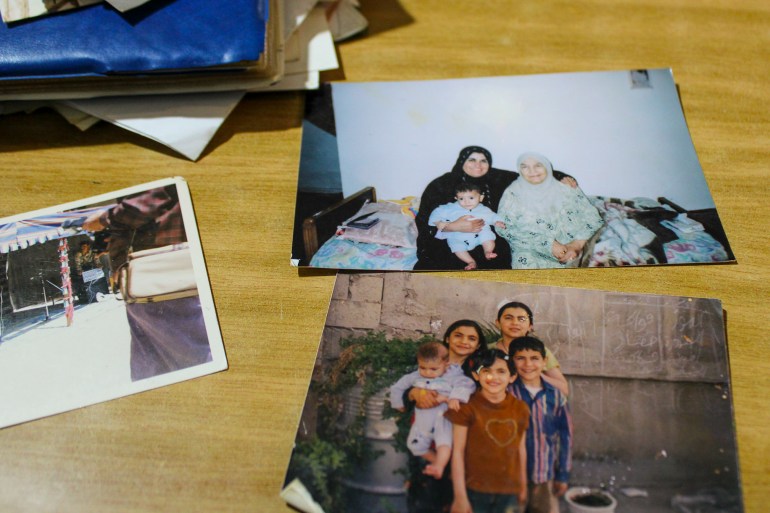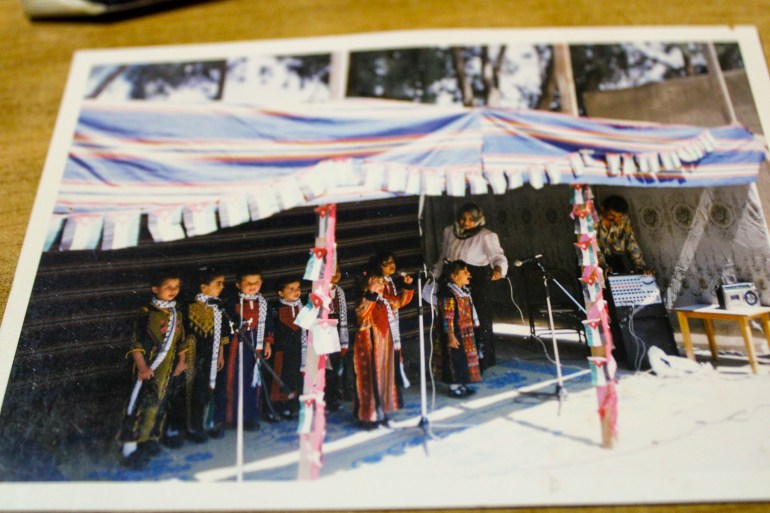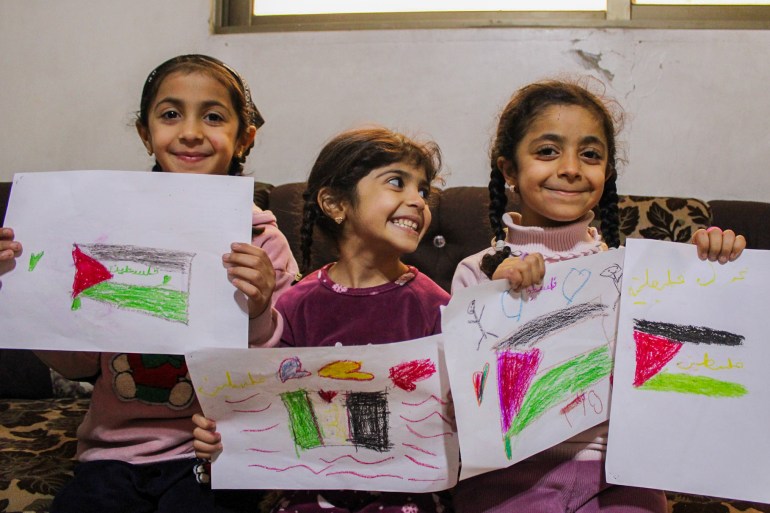‘We will never forget’: Reliving the pain of the Nakba amid Israel’s war | Israel-Palestine conflict
Baqaa, Jordan – Rain pours down in torrents on Jordan’s Baqa’a camp, turning the streets into rivers. The November storm’s harsh winds rattle the tin doors of thousands of homes in the largest Palestinian refugee camp in the country. But despite the heavy downpour and bone-chilling cold outside, it is warm inside the Nashwan family’s home.
Eighty-six-year-old Abdullah Nashwan beams at his great-grandson, Tayem, just one year old. His three grandchildren smile as they sift through a box of old family photos over a steaming pot of mint tea.
Abdullah’s daughter-in-law, Kausar, pulls out a photo of Abdullah and his wife Fatima, who passed away 10 years ago. “I remember her thobe [traditional Palestinian dress]. She always wore it,” Kausar’s 20-year-old son Mohammad recounts.
Kausar brings out a long velvet dress from the bedroom. It is worn, but its violet, green, pink and yellow hues are still bright, intricately stitched into a pattern of flowers. When Abdullah sees the dress, he freezes, staring deeply as if his wife had appeared from the fabric’s folds.
Like other Palestinian thobes, the embroidered pattern is unique to the woman’s village. For Abdullah’s wife, this is a town called Dawaymeh, high in the hills of al-Khalil (Hebron), in what is today the occupied West Bank.
A sharp contrast to the camp, where the thickly packed cement structures suffocate most of the plants, Dawaymeh was very green. Olive groves and expansive gardens were neatly planted on terraces etched into the mountainside, Abdullah recounts.
“My father was a farmer,” he says. “We owned a few dunums, where we planted wheat and barley. We lived off the land, and there was plenty to eat and drink. Everything was lovely,” he says.
“I wish I could return,” young Mohammad, who wears a black-and-white keffiyeh around his head, says. “I want to see all of Palestine. Not just Dawaymeh, everything.”
Coming to Jordan
Abdullah brought his wife and children to Baqaa in 1967. They did not come straight from Dawaymeh, as this was not the first displacement for Abdullah and his wife, but it was the first for the six children.

Abdullah’s 57-year-old son, Saadi, Mohammad’s father, grew up in Baqaa. He was four months old when they arrived in the newly established camp, he tells Al Jazeera.
“The camp was covered in mud up to here,” Saadi gestures to his knee, remembering how unfinished the infrastructure was when he was a child.
Saadi and five of his siblings were born in a refugee camp in Jericho, where his parents had fled as children with their own parents during the Nakba of 1948, when an estimated 750,000 Palestinians were forced to leave their homes and land during the creation of Israel.
In 1967, the war between Israel and a coalition of Arab nations led by Egypt, Syria and Jordan ended with Israel in control of the West Bank, East Jerusalem, the Gaza Strip, the Sinai peninsula and the Golan Heights. The family was uprooted again, like some 430,000 Palestinians, with most fleeing into neighbouring Jordan.
Saadi went to school in Baqaa and his father worked as a cook for the UN Agency for Palestine Refugees (UNRWA). As the years passed and the tents gradually transformed into concrete homes, Abdullah and his wife had four more children.
Today, most of Abdullah’s 10 children have moved out of the camp, to Jordan’s capital city, Amman, and other governorates.
But Saadi still lives just around the corner from his father, although life in the camp has not been easy, he says.
Tamara Alrifai, UNRWA spokeswoman, told Al Jazeera unemployment and poverty rates are high in Baqaa and budget deficits are threatening the agency’s services, such as education and healthcare.
“We are surrounded by hardship. We are refugees, guests here. We don’t have the freedom to express our thoughts,” Saadi says.

The ‘Nakba’
Abdullah arrived in the Jericho refugee camp as a child of 11 and lived there for more than 20 years, growing into adolescence, getting married and having six children with his wife.
He had walked 50km (31 miles) with his family to get there from Dawaymeh in 1948.
On October 28, 1948, Zionist fighters approached the village and opened fire with automatic weapons and mortars, according to the mukhtar (village chief), Hassan Mahmood Ihdeib.
Some of the 4,304 villagers fled, while others took shelter in a mosque and a nearby cave. When the mukhtar returned to the village to check on them, he found the bodies of about 60 men, women and children in the mosque and the bodies of 85 more in the cave. He recorded a total of 455 people missing.
The village was destroyed. In its place now is the Israeli settlement of Amatzya.
Abdullah’s family was among those who fled. “We didn’t even take our clothes,” Abdullah explains. There had been no time to gather their belongings.
In 2016, an Israeli soldier wrote in the Israeli newspaper, Haaretz, about what he had seen in Dawaymeh. He estimated that between 80 and 100 people were killed, including children, by having their “skulls smashed”. Women were raped, then shot.
Throughout Palestine, the militias expelled more than 750,000 Palestinians from their villages, destroying homes and killing thousands. The events, mourned as the Nakba (catastrophe in Arabic), were followed by the creation of the state of Israel.
During Israel’s ongoing bombardment of Gaza following the October 7 Hamas attack on southern Israel, a number of Israel’s far-right politicians have clearly stated that they want a “second Nakba”, stirring up painful memories of massacres like the one in Dawaymeh.
Israeli Prime Minister Benjamin Netanyahu has called the Israeli bombardment of Gaza a “second war of independence”, referencing what Israelis call the events of 1948.
Ariel Kallner, a member of parliament from Netanyahu’s Likud party, wrote on social media: “Right now, one goal: Nakba! A Nakba that will overshadow the Nakba of 48. Nakba in Gaza and Nakba to anyone who dares to join!”

Watching Palestine’s pain again
The images of thousands of Palestinians in Gaza piling whatever belongings they can carry into cars and donkey carts, or on their backs as they trek on foot, are painfully similar to the images Abdullah remembers of the Nakba.
With more than 70 percent of Gaza’s 2.3 million people displaced by Israel’s attacks, this is the largest mass displacement of Palestinians in 75 years.
At Abdullah’s home, the television is stuck on the Al Jazeera Arabic channel for hours, broadcasting the immense destruction in Gaza.
The TV presenter speaks to a young mother, nursing her child while sheltered in a tent. She holds a piece of bread in her hand and says there is not enough to eat.
Saadi says that his father is devastated by the war, the terrible images reminding him of his two-times displacement. “We are watching Palestine fall apart,” Saadi says.
However, in the stories ingrained in Saadi’s memory, Palestine is alive and vibrant. Growing up, he says, he would sit beside his father and soak up all his stories.
“The land is rich,” he says. “There are no fruits and vegetables anywhere like those from Palestine.
“Our homes are Palestinian. Our blood is Palestinian.”
Saadi has six children who all still live in Baqaa, and who have absorbed the stories of Palestine. “From the youngest family member, the son of my son, Teem, to the oldest, we don’t forget Palestine,” he says. “And we will never forget.”
Saadi’s eldest child, 31-year-old Alaa has three daughters of her own now. “My daughters already know everything about Palestine,” she says.
Alaa shows a video of her oldest daughter, seven-year-old Tala in a keffiyeh at a school performance, singing “Filestini ana ismi Filestini” (Palestinian, my name is Palestinian, in Arabic). It resembles an old photo of Alaa when she was about Tala’s age and singing at school.
In the photo of young Alaa, she wears the traditional Palestinian thobe, just like her grandmother.

Alaa says she teaches her daughters everything her grandmother taught her: the food, the songs, the traditions and the stories.
She cooks her daughters the same dish her grandmother, Fatima, used to make for her: kusa with leban (zucchini with yoghurt). “You boil the zucchini, then smash it, then mix it with yoghurt and garlic,” she recounts, explaining how her grandmother used to prepare it.
Alaa turns to her two younger daughters, four and six years old, and starts singing “Ya bayy Miriam”, a folk song often sung at weddings, the girls giggle.
The three young girls then pull out their drawings of the Palestinian flag. Their mother says they drew for the children of Gaza. “We are destroyed, just like them [in Gaza],” Alaa sighs.

Inside Alaa’s grandfather’s home, the television rolls on, showing the expansive displacement camps in Gaza; the white tents lined neatly like those once in Baqaa camp in 1967.
When the rain finally slows to a trickle, Abdullah steps outside. The rolling green hills of Abdullah’s childhood were levelled years ago, to make space for a new Israeli settlement. But when Abdullah walks into his yard, he remembers.
Over the past 50 years, he has built a small garden. Vines with yellow flowers creep above the foyer and bright green, potted plants line the entryway.
Abdullah pauses to touch one of the leaves and then bends over to smell the flowers. They remind him of Dawaymeh, he says.
Source link
